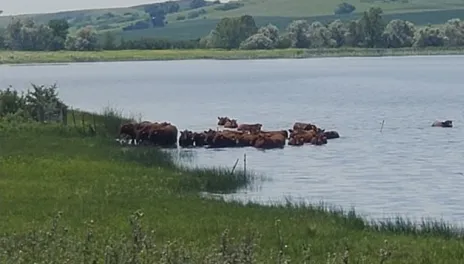Do cows need to swim?
Going for dip in the lake on a hot day sounds inviting, doesn’t it? When given the opportunity, cows, calves, and bulls will go wading, or even floating, in a refreshing lake. Is it a reprieve from the heat, or the flies, or both?
In a feedlot, cattle will find any wet low area and stand there. Think of it like running cold water over your wrists on a hot day. There is a lot of blood flow to the hooves of cattle, so standing in water or mud helps with heat dissipation…. and it keeps the flies away.
Temperature and humidity can work together to make an uncomfortable day for cattle. If cattle are panting, they are in heat stress. To relieve heat stress, provide adequate water and space for cattle to drink. During periods of extreme heat stress, extra tanks filled with drinking water are helpful in providing relief to cattle. Don’t move heat-stressed cattle because walking creates dust that impairs breathing and generates extra body heat.
Each ranch, pasture, or feedlot will have differences in temperature, humidity, and wind. The USDA provides regional heat stress forecast maps. The 7-day forecast maps for cattle heat stress are found at https://www.ars.usda.gov/plains-area/clay-center-ne/marc/documents/heat-stress/main/
Shade provides relief from direct sunlight. Cattle with black hides will quickly seek shade. Genetically, Braham or Braham-cross cattle are somewhat tolerant of heat. However, these smart long-eared cattle sought shade under Florida palm trees.

Cattle on pasture will find locations like hill tops where wind can provide relief from the heat. Feedlot cattle may have difficulty catching a breeze since feedlot shelterbelts are established to slow the winter wind and catch drifting snow. Some feed yards have added portable shades for summer sun relief.
North Dakota usually has cooler nights with temperatures that drop below 72 degrees. Night cooling provides a chance to cool off from extreme daytime heat. Cattle are very prone to heat stress when there are three consecutive hot days without night cooling. Extreme heat stress can result in death and therefore steps to provide relief should be considered when extended heat stress is forecasted. Set extra water tanks, provide access to shade, wet the pen surface for feedlot cattle, and feed in the evening. Feeding in the evening helps move the heat created from digestion to night time rather than during the hottest part of the day.
The trifecta is where cattle find a place to stand with all three: wind, shade, and water. Most cattle ranchers find that this trifecta usually brings a problem, though -- foot rot infections can develop in cattle standing in water and mud.
NDSU Extension has more information in publication AS1615 Dealing with Heat Stress in Beef Cattle Operations.
And remember, even our tough native bison will head for a slough to find relieve from hot weather on a 100-degree day.
Karl Hoppe, Ph. D.
Karl.Hoppe@ndsu.edu
Extension Livestock Systems Specialist
